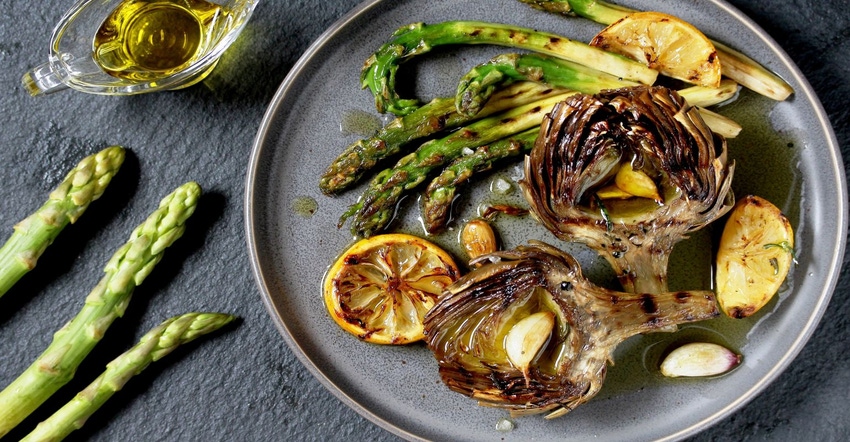Gaining popularity as a prebiotic fiber, inulin offers formulation advantages as an alternative to sugar or fat—including moisture retention, food texture stabilization and mineral absorption enhancement.

Fiber is a crucial part of a healthy diet—and to help with fiber absorption, inulin is available as an alternative to sugar or fat that does not interfere with fiber intake. Known as a fructan, inulin is a naturally occurring carbohydrate found in vegetables and fruits.1
Origins of inulin
Inulin is considered a normal part of the human diet, as it is naturally found in artichokes, asparagus, leeks, onions, garlic and chicory. In fact, inulin naturally occurs in 36,000 species of plants.2 Humans have safely and regularly consumed inulin since the days of hunting and gathering. With a mostly plant-based diet, some early humans consumed far more inulin than modern humans at roughly 135 grams a day.3
Chicory’s reliably high inulin content makes it a popular source of dietary fiber. Inulin occurs in its most concentrated state in the chicory plant’s roots—from which the substance is extracted for industrial purposes.3
Benefits of inulin
A study from The Journal of Nutrition noted inulin is a replacement ingredient for fat and sugar that can enhance fiber, retain moisture and stabilize food textures.1 Inulin consumption has shown to enhance the absorption of minerals and stimulate the immune system. Additionally, inulin has self-affirmed GRAS (generally recognized as safe) status in the U.S.1
The ingredient is used as a prebiotic, meaning it can help stimulate the growth of beneficial intestinal bacteria while restricting the growth of harmful bacteria.4 Inulin increases gut health and promotes healthy bacterial growth, specifically the Bifidobacteria and Lactobacilli species.4 These helpful bacteria allow the human body to fight off pathogens, stimulate immune responses and aid healthy digestion.
Inulin has exceptional organoleptic quality, meaning it enhances the sensory experience of food—including the texture, odor, smell and taste—without adding any flavor into the food product.5
Published research from a food and fiber summit in Washington, D.C., noted: “Adequate intake of dietary fiber is associated with digestive health and reduced risk for heart disease, stroke, hypertension, certain gastrointestinal [GI] disorders, obesity, type 2 diabetes and certain cancers. According to consumer research, the public is aware of the benefits of fiber and most people believe they consume enough fiber. However, national consumption surveys indicate that only about 5% of the population meets recommendations, and inadequate intakes have been called a public health concern.”6
As an ideal solution to address nutritional deficiencies in the American diet, inulin possesses different fiber characteristics, possibly contributing to a diet with well-rounded sources of fiber.
The benefits don’t stop there. High-fiber diets have been shown to decrease the likelihood of colon cancers.7 According to a study published in the American Journal of Clinical Nutrition, elevated total dietary fiber intake was associated with a "significantly reduced risk" of certain types of cancer, including colon cancer. Acting as a source of fiber, consistent consumption of inulin may contribute to a healthier colon.
Inulin as a fat replacement
Bonds linking fructose molecules in inulin prevent digestion by intestinal enzymes, meaning that inulin passes through the digestive tract without being metabolized.5 The calories, therefore, are not digested, making this ingredient an optimal option for low-calorie foods. Inulin allows low-fat food to still taste and feel like foods with their original fat levels because it increases stability and preserves the emulsion of the food product. A small amount of inulin added to low-fat dairy products improves the flavor and texture.5
Another unique characteristic of inulin is its ability to mimic fat in food products. When combined with a liquid such as water, inulin forms a gel-like substance that replicates the fatty mouthfeel of real fat in foods and ingredients.4 Plus, it maintains its melting and freezing properties. This allows for easy substitution of fat in foods. For consumers wanting to stick to a low-fat diet, butter, cream cheese, processed cheese and more don’t have to be off the table. Inulin creates impressive low-fat food alternatives that maintain the taste and feel of their original counterparts.
A “high performance” type of inulin was recently introduced to the market, making low-fat options even more viable. High performance inulin provides almost twice the fat-mimicking characteristics compared to other types of inulin while adding no sweetening aftertaste.5
Considering the risks
Inulin has been found safe by a multitude of studies.1 Side effects like bloating and flatulence may occur at high doses, but these concerns are applicable when fiber of any kind is consumed quickly or in large quantities.
Inulin and oligofructose are gaining gradual acceptance as ‘‘dietary fibers,’’ and the mention of their ‘‘bifidogenic effect’’ (enhancing the growth of Bificobacteria) has become commonplace and legal in many countries.1
The state of inulin market
In North America in 2021, the inulin market's estimated value was $285 million with the United States accounting for over 80% of the market, per a Transparency Market Research report. The global inulin market is estimated at around $1 billion. With the increasing demand for inulin in the pharmaceutical industry, rising consumption of sports nutrition and nutraceutical products, a desire for naturally derived products and high consumption of inulin as a fat replacer, word about inulin is spreading quickly and the market reflects these trends. As people recognize the value in inulin, it is impossible to ignore that the market is thriving.
The time is now
The options for formulating with inulin are essentially endless. With its fat-mimicking capabilities, inulin provides healthier options for those who want or need to consume less fat with little to no adverse side effects. Studies have shown the safety and reliability of inulin, which hunter-gatherers consumed in far greater quantities than generally seen today. Inulin can potentially aid colon wellness, boost immune systems and contribute to healthy blood sugar levels. And the additional benefits to texture and taste can provide extra appeal from a formulation perspective. For companies interested in formulating with inulin, the time is now.
For additional related content, check out the “Functional fiber gets friendlier” digital magazine.
Bob Wills has worked in the specialty chemical, food additive and ingredient distribution industry since 2008. He is the director of business development, human nutrition, for Barentz. Previously, he was a director of sales for Viachem, where his responsibilities included management of the food, beverage and nutritional market segments, coordinating and managing sales efforts, and pursuing growth opportunities on the producer and end-user level. Wills wants potential producer partners as well as end-users to make the most educated decisions possible about what goes into their products.
References
1 Coussement PAA. “Inulin and Oligofructose: Safe Intakes and Legal Status.” J Nutr. 1999;129(7):1412S-1417S.
2 Shoaib M et al. “Inulin: Properties, health benefits and food applications.” Carbohydr Polym. 2016;147:444-454.
3 Leach JD and Sobolik KD. “High dietary intake of prebiotic inulin-type fructans in the prehistoric Chihuahuan Desert.” Br J Nutr. 2010;103(11):1558-1561.
4 Wu XZ et al. “Effects of dietary inclusion of Lactobacillus and inulin on growth performance, gut microbiota, nutrient utilization, and immune parameters in broilers.” Poult Sci. 2019;98(10):4656-4663.
5 Niness KR. “Inulin and Oligofructose: What Are They?” J Nutr. 1999;129(7):1402-1406.
6 Quagliani D and Felt-Gunderson P. “Closing America's Fiber Intake Gap: Communication Strategies From a Food and Fiber Summit.” Am J Lifestyle Med. 2016;11(1):80-85.
7 Kunzmann TA et al. “Dietary fiber intake and risk of colorectal cancer and incident and recurrent adenoma in the Prostate, Lung, Colorectal, and Ovarian Cancer Screening Trial.” Am J Clin Nutr. 2015;102(4):881-890.
About the Author(s)
You May Also Like






